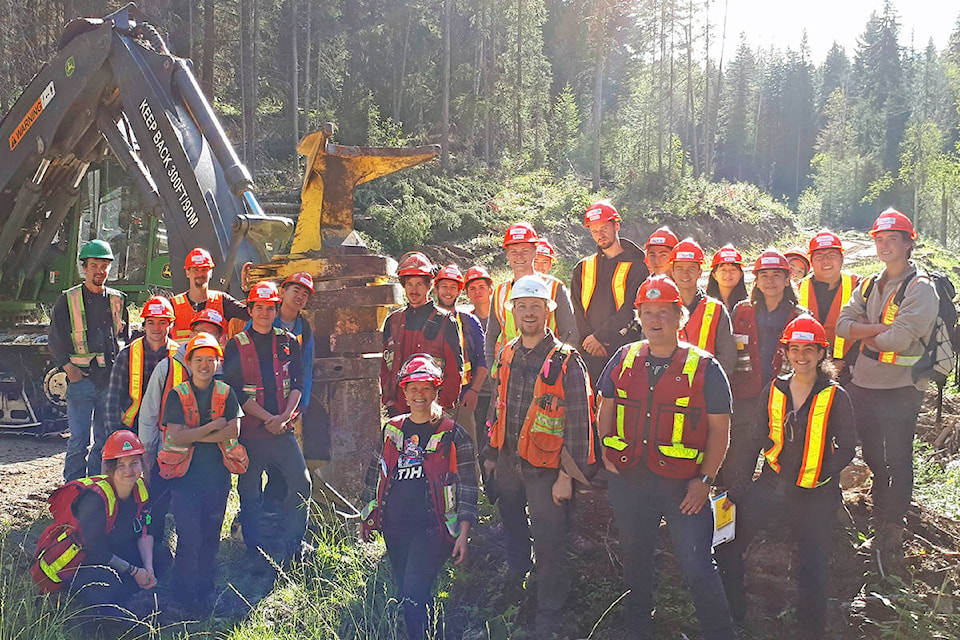As mills continue to close and fears are raised about the sustainability of the B.C. Lumber industry, organizations like the Alex Fraser Research Forest are working to educate the next generation of foresters and environmental stewards with hands-on experience.
The Alex Fraser Research Forest consists of 10,000 hectares of Crown forest that has been set aside for the purpose of research and education conducted by the Faculty of Forestry at the University of British Columbia. Its primary goal over the last 36 years it’s operated is to find ways to enhance British Colombians’ and Canadians’ approach to maintaining sustainable forest ecosystems, to protect industry, the environment and our way of life.
Currently, the forest is managed by Stephanie Ewan, a UBC graduate herself, who primarily co-ordinates between researchers at the university and those maintaining experiments and installations in the forest. She also works with local forestry community members and will pass along their ideas and questions to the university to be incorporated and then implemented in future research.
“Since the fires we’ve had quite a bit of interest in fire research. Specifically, regeneration post-fire and the difference between salvaged areas and un-salvaged areas would be one project that is happening right now,” Ewan said.
Read More: Research forest opts for sustainable xeriscape garden
Looking at ways to reduce the severity of fires through commercial thinning and examining the continuing impact of the Douglas Fir Beetle are also important ongoing projects right now, Ewan said. Silviculture, regeneration and wildlife habitat management are also common areas of interest and study.
She believes that we’re coming to the end of the era of salvage logging from the pine beetle days and with the reduction of the annual allowable cut, it’s up to people like her to find creative ways to manage that cut. Research projects should start to examine this reality, Ewan said, while at the same time studying the impacts of climate change on our ecosystems specifically in regards to changes of stand structures.
One of the things the research forest does every year, which Ewan herself got to participate in as a student, is a field school course they hold for UBC students. It is specifically open to students going from second year of the Forest Research Management and Forest Operations program into the third year within the Forestry Department at UBC.
“They don’t get a lot of opportunity throughout the school year to experience Interior ecosystems, Interior silviculture systems and management challenges,” Ewan said. “So, we host them up here every year for an eight-day course and we take them out to the woods and expose them to as many things as possible so that when they’re sitting back in the classroom they can have that picture in their mind of what different things look like in the field.”
This hands-on experience of tramping through the forest is beloved by the students, Ewan said, with she and her staff consistently receiving positive feedback and praise from the students after the conclusion of their lessons. Even years after attending, students will reach out and tell them they’ve been able to keep these mental images in their head throughout their education and into their careers.
While they learn a lot of theory in class, Ewan feels the information doesn’t quite sink in the same way until they’re out in the field digging their own soil pits, identifying plants and measuring trees. To this end, she always encourages university students who come through the program to take summer jobs in the forestry industry to get more hands-on experience while interacting and learning from professionals.
Read More: Christmas arrives early for Alex Fraser Research Forest
This year 39 students came out to the Alex Fraser Research Forest the week prior to the Labour Day long weekend to learn from Ewan and her team, which is down from their usual numbers of 70 to 75. The smaller group proved to be fantastic, however, as Ewan said, it gave them a four-to-one student to instructor ratio which allowed them more time to devote to each student’s questions.
It’s not all just walking around the forest, however, as Ewan dedicates a day where they take the students to an active logging site followed by visiting a local mill. This helps them understand the scale of the industry and gives them a real introduction to the importance of the industry.
They’ll go on to become the future forest health professionals, silviculture specialists, company management, landscape management, government works and dozens of other roles.
patrick.davies@wltribune.com
Like us on Facebook and follow us on Twitter
